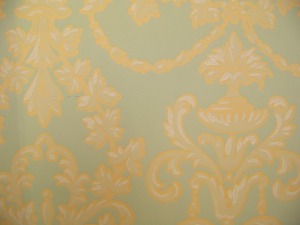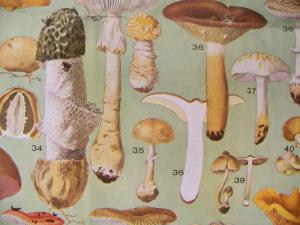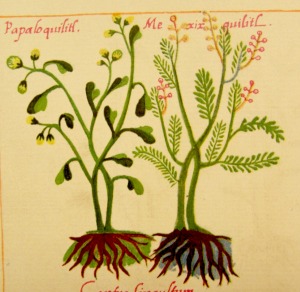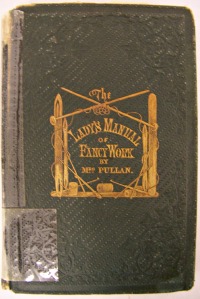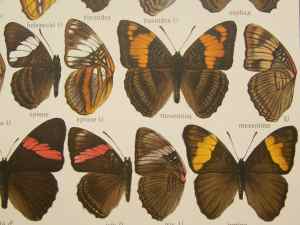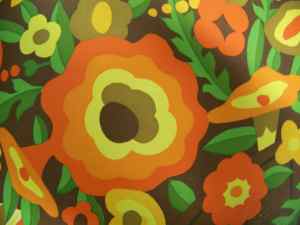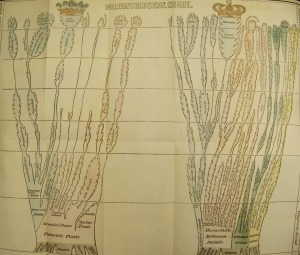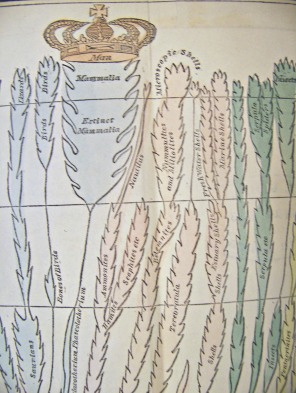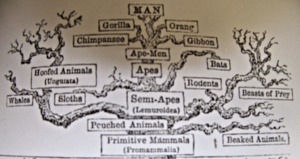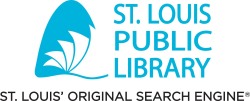698.6: Paper Pushers
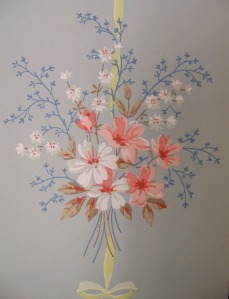
Detail from a wallpaper sample in "Wallpaper: what it is and how to use it" by Devoe and Raynolds Co., 1947
Since its earliest use, wallpaper has represented the most “in” trends in interior design, and the most “out”. Like fashion, tastes in wallpaper patterns change frequently, and designs inevitably come to be associated with a certain time period. Unfortunately, this means old wallpaper has the potential to look completely out of style. However, when used thoughtfully, the ability of wallpaper to create visual connections to the past may be used to the designer’s advantage. Many designers and historic rehabbers use wallpaper to create period or vintage-inspired rooms that effectively integrate patterns of the past.
If you’re thinking of using wallpaper, consider a free consultation with your local librarian. Although we may not be fashion experts, we can certainly recommend resources that will help you decide what designs are right for your project. For example, Fabrics for Historic Buildings: a guide for selecting historic fabrics by Jane and Richard Nylander, 2005, is an excellent book that surveys fabric and wallpaper trends from the 1700s to the 1930s.
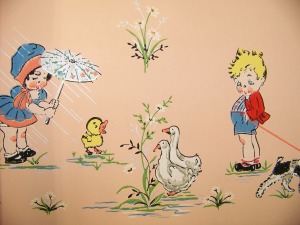
Detail of a wallpaper sample in "Wallpaper: what it is and how to use it" by Devoe and Raynolds Co., 1947
The images in this post are from another great St. Louis Public library book called Wallpaper: what it is and how to use it, published in 1947 by the DeVoe & Raynolds Company. The book is an oversized catalog of actual vintage wallpaper samples.
Of course, we also have many do-it-yourself books about wallpaper installation, magazines about interior design, and we can even help you find wallpaper suppliers.
To do some searching of your own, use “wallpaper” as a “word or phrase” search in our online library catalog. If you find something you like, you can use your library card to place a hold, and request that the book be sent to your local library branch.
589.2: Mushroom Hunting
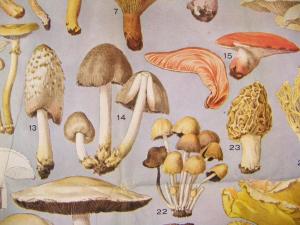 According to Maxine Stone, past president of the Missouri Mycological Society and author of Missouri’s Wild Mushrooms, April to early May is the best time to find morel mushrooms in Missouri. So if you’ve never been mushroom hunting, but might like to try, come by the library and check out a copy of Stone’s book. The book is well organized and includes color photographs of wild mushrooms. It covers a wide range of mushroom-hunting topics such as identification, ethics, cooking, preservation, and more.
According to Maxine Stone, past president of the Missouri Mycological Society and author of Missouri’s Wild Mushrooms, April to early May is the best time to find morel mushrooms in Missouri. So if you’ve never been mushroom hunting, but might like to try, come by the library and check out a copy of Stone’s book. The book is well organized and includes color photographs of wild mushrooms. It covers a wide range of mushroom-hunting topics such as identification, ethics, cooking, preservation, and more.
To hunt for more books about mushrooms at the library, just browse under the call numbers 579.6 or 589.2.
Pictured in this blog post are details of a beautiful chart from a two-volume book I found in the stacks. The 1916 book, titled Edible and Poisonous Mushrooms, is by famous American mycologist (mushroom scientist) James Murrill (1869-1957). The first volume consists entirely of the oversized mushroom chart, which folds up neatly to fit inside an ordinary-looking book. The second volume is a handbook that describes the chart. A truly tasty set for mycophiles and bibliophiles alike! Happy hunting!
Collections of Alexandre Dumas
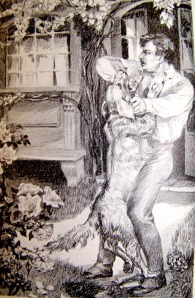 Alexandre Dumas (1802-1870) was a prolific mid-19th century French writer who is best known for his thrilling adventure stories like The Three Musketeers and The Count of Monte Cristo.
Alexandre Dumas (1802-1870) was a prolific mid-19th century French writer who is best known for his thrilling adventure stories like The Three Musketeers and The Count of Monte Cristo.
581.97: Cactus Grabber
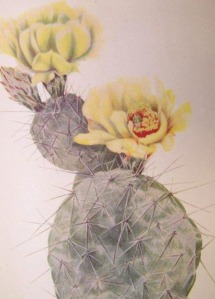 North American Wildflowers by Mary Vaux Walcott, 1925
North American Wildflowers by Mary Vaux Walcott, 1925
Mary Vaux Walcott was an American artist and naturalist who was fascinated by nature, and is most remembered for her sensitive and accurate watercolor paintings of wildflowers (although, there is also a mountain named after her, which, I mean—that’s kind of a big deal, right?).
In 1925, the Smithsonian Institution published Walcott’s North American Wildflowers. This five-volume set contains 400 unbound prints from her original paintings, along with descriptions of the flowers, and some of her personal anecdotes from the field.
Pictured above is Walcott’s elegant interpretation of our own bristly beauty–the Missouri Prickly Pear Cactus (Plate 35). As the name suggests, the plant is native to Missouri, but it actually has a wide range throughout the Eastern and Central United States. It is most common in rocky, dry areas.
Of the Prickly Pear, Walcott writes,
“The flowers are so beautiful that one forgets the wicked spines and the still more dangerous spicules…until one endeavors to gather them”
…so take it from Mary…This Spring, look but don’t touch! These cacti don’t play.
The book is part of the “stacks” (old, cool, and important books) at the Central Library, which is currently closed for restoration. However, if you’re interested in seeing Walcott’s other flowers, email Librarian Brian Novak to make an appointment to see the book at another St. Louis Public Library Branch.
615.32: Medicine Chest
While the best way to get medical information is to speak with a medical professional, the Saint Louis Public Library offers an incredible collection of authoritative, up-to-date medical reference resources including books, periodicals, and databases. These resources cover current medical theories and practices from a variety of perspectives, and are useful to all library users from general readers to in-depth researches.
On the other hand, if you’re curious about historical or “fringe” medicine and medical practices, we have some of that too–although you might be surprised at what you find:
For example, check our copy of a 1940 translation of the Badianus Manuscript, a 16th century book of Aztec herbal remedies. The book features reproductions of original illustrations from the manuscript, along with recipes calling for all kinds of bizarre ingredients from mole bile to dove poop!! Pictured above is an illustration of plants that are part of a remedy for hiccups.
If that’s not enough to cure your itch for historical medical information, check out our copy of a 1925 reprint of The Receipt Book of Ann Blencowe, first published in 1694. The book mainly consists of recipes for extremely unappetizing food (spinach pudding, anyone?), but Ms. Blencowe also includes a chapter of extremely unappetizing (and probably not recommended) recipes for medicine.
Here is Ms. Blencowe’s recipe for Horse Dung Water, which she recommends for women in labor (the unfamiliar spelling is from the book):
“To make ye horse dunge water:
Take horse dunge and putt to it so much Ale as will make it like hasty pudding, and put it into your still. Then putt on ye topp one pound of treakell and a quarter of a pound of genger in powder, and a quarter of a pound of sweet aniseeds, and so distill all these together.”
…and there’s more where that came from! Contact Brian Novak bnovak@slpl.org in the Science and Technology Department to develop a search strategy for finding more historical medical books and disgusting recipes!
As always, for current medical information, no special strategy is required–Just use our catalog at slpl.org or visit any of our library branches. Browse the 610-619 dewey range.
Fancy Update: Not Just for Ladies!
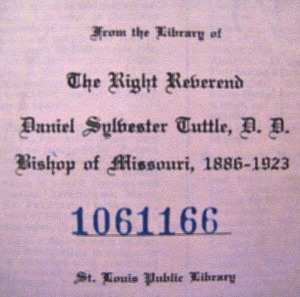
- This bookplate, or “ex libris”, was found in “The Lady’s Manual of Fancy Work”, and indicates that the book came from the library of Bishop Tuttle
Those of you who follow “I Browse” know that the blog showcases rare, quirky, or otherwise awesome books from the collection of the St. Louis Public Library.
746: Fancy Work
The Lady’s Manual of Fancy Work by Matilda Marian Chesney, 1859.
Before finding this enchanting mid-nineteenth century book by Matilda Marian Pullan, I would have guessed that the term “fancy work” referred to any job done in a fancy manner, such as holding a brick trowel with your pinky raised, or skipping to the dumspter with your garbage.
595.78: Thousands and Thousands of Butterflies
The Macrolepidoptera of the World, by Adalbert Seitz
…Another amazing resource from the collection of the St. Louis Public Library!
This fascinating and stunning work by German entomologist Adalbert Seitz was his attempt to catalog all the butterflies and moths of the world.
In all, the set contains 16 volumes, with over 1400 (!) chromolithographed pages of butterflies and moths.
Production on this magnum opus began in the first decade of the 20th century in Germany, and volumes continued to be issued into the 1950s, when the project was abandoned.
The books were printed in German, English, and French. The St. Louis Public Library is fortunate to own all 16 volumes of the German edition (Gross-Schmetterlinge Der Erde), and some volumes of the English version.
You can see more at the Biodiversity Heritage Library, a digital library created and maintained by a group of natural history and botanical libraries, including the Missouri Botanical Garden Library. The images of Seitz’s work in this online resource were contribuited by the Smithsonian Libraries.
To arrange to see the butterflies in person, please contact Brian Novak at www.slpl.org
535.6: Monument to Color
Monument to Color by Faber Birren (1938)
550: Trees of Life–Phylogeny at the Library
Organization is one of the primary concerns here at the library. At the St. Louis Public Libary, we use the Dewey Decimal System to help classify over 4.5 million items.
…But librarians aren’t the only ones with organization on the brain–for example, scientists concerned with the study of phylogeny attempt to chart the evolutionary history of all the world’s organisms. Sort of like a gigantic family tree.
We have a couple of amazing examples of “phylogenic trees” at the library, including the above example by 19th century Geologist and third President of Amhurst College, Edward Hitchcock. I came upon this beautiful, hand-colored “Paleontological Chart” tucked inside his 1844 book, Elementary Geology (3rd edition). It may look more like fuzzy seaweed than a tree, but it is absolutely gorgeous.
Another example of a “tree of life” is found in Ernst Haeckel’s 1897 book, The Evolution of Man. Unlike Hitchcock’s chart, which reflects his theory that a Diety was the agent of change in regard to the history of organisms, Haeckel’s tree has more in common with Charles Darwin’s theory of evolution.
Visions of Nature: The art and science of Ernst Haeckel, by Olaf Briedbach (2006)
New Thinking about Evolution, by John Raffety (2011)
Survival of the Beautiful: Art, science and evolution, by David Rothenberg (2011)
